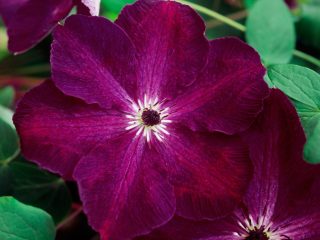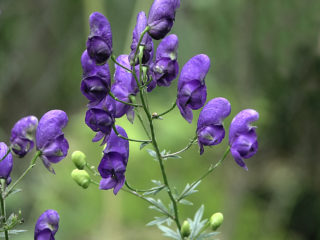Content
Lily Mapira is an Asian variety that is interesting for gardeners, first of all, for the color of its petals. Shades of burgundy color may change under different lighting conditions, which is unusual for this crop.
History of selection
Work on Asiatic lilies began actively in 1949. Breeders Jan de Graaf and S. Peterson made a great contribution to the creation of many Asian varieties. Through their efforts, a group of hybrids called Mid Century (Mid Century) was bred. They were based on the following varieties: Lily (Lillium cernuum) with anthocyanin-colored buds and Lily of David, as well as tiger, bulbous and some others. Now Asian women are the largest group included in a single international classification.

At the base of the petals of the Mapira variety, small pink streaks give a glowing effect
Lily Mapira is an Asian hybrid obtained in 2013. The variety was created in the Netherlands by specialists from the seed company Mak Breeding B.V.
Description of the Mapira lily with photo
The Asiatic lily variety Mapira has the following characteristics:
- The bulb is dark red in color with yellow and brown splashes, consists of open juicy scales, up to 8 cm in diameter.
- The stem is straight, ranging from 90 to 130 cm in height.
- The leaves are large, elongated, the veins are almost invisible, the tips are slightly curved.
- The leaf blade is smooth, glossy, rich green.
- The flowers have a weak aroma, the petals are dark burgundy, almost black at the base, up to 15 cm in diameter, non-double, star-shaped, the anthers are bright orange.
- The tips of the petals are slightly bent back, and the side edges are slightly curled upward.
- Several buds are formed on the stem - 5-15 pieces, each flowering lasts 4-5 days.
- The buds bloom from bottom to top; in general, the plant can bloom for about one and a half months.
The Mapira variety can be used in group plantings in flower beds and mixborders. When cut, a lily can stand for two weeks.

To achieve long-term standing of the variety in a vase, every day you need to trim the lower part of the stem by 1 cm
Features of flowering
Mapira lily is preferably planted in partial shade. In bright sun throughout the whole day, flowers can fade, which shortens the decorative period. In addition, such conditions will cause the buds to become smaller over time.
Winter hardiness
The variety has high winter hardiness and can withstand frosts down to -34 °C. The Mapira lily can be cultivated even in the Urals and Western Siberia.
Advantages and disadvantages
The Mapira lily variety is in demand among flower growers due to its good characteristics.

The Mapira lily variety has decorative not only flowers, but also leaves
Pros:
- decorative and original coloring;
- unpretentiousness of cultivation;
- high frost resistance;
- stands for a long time when cut.
Minuses:
- cannot withstand bright sun;
- the stem may break under strong gusts of wind.
Planting the Mapira lily
Planting bulbs in the spring begins only when the ground warms up to +8 °C. Autumn planting is also possible in the second half of September. The bulb must grow roots in the soil before frost for wintering to be successful.

Mapira lily bulbs are germinated in moist peat before planting.
Choose a place on the site where there will be a light, lacy shadow in the afternoon. This will protect the lily petals from burning out. For the same purpose, tall shrubs can be planted nearby, which would also partially shade the crop.
Asiatic lilies do not like alkalizing soil. The reaction should be neutral or slightly acidic with a pH level of 5.5-6.
Before planting, the soil in the future bed must be dug up using a spade, having previously scattered loosening materials on the surface: peat, sand, compost. For 1 sq. m. also add 1 tbsp. l. nitroammofoski.

Mapira lilies can be planted in small circular groups
The holes are made at a distance of 30 cm from each other. The depth should be equal to the height of the bulb, multiplied by 2. Before planting, a handful of humus mixed with sand can be placed in the hole directly under the seed.
Caring for the Mapira lily
Caring for Mapira is not difficult, but it must be done regularly, which will ensure good growth and development of the plant.
Water lily beds no more than once a week. More frequent watering will cause the bulb to become waterlogged, which can be detrimental to it.
It is necessary to trim dry, faded buds. They spoil the decorative effect of the entire plant and delay the blooming of other flowers.
After complete flowering, there is no need to rush to cut off the entire stem, although this will slightly spoil the appearance of the flowerbed. During this period, the bulb gains weight due to the leaves, and if you cut off the shoot, then, of course, it will not die, but growth and development will stop.
Asian hybrids rarely get sick, but still, preventive treatments against fungal diseases will not hurt.

Loosening and weeding of lilies will provide the root system with the influx of oxygen it needs.
Fertilizing is carried out twice during the entire growing season: in the spring, immediately after the leaves begin to grow. Then fertilize again after complete flowering. Use a special complex fertilizer for lilies or a universal one - Nitroammofoska.
Reproduction methods
There are several ways to propagate the Mapira lily:
- dividing the rhizome;
- children that form on the stem above the bulb;
- scales.
Lily Mapira can grow in one place for up to 3-5 years. Then the overgrown rhizome needs to be transplanted to another place. When digging, the bulbs are disassembled and sorted by size. Large ones are planted in another flowerbed; they will bloom the next year. Small ones with a diameter of less than 5 cm are planted in a separate bed and grown to a large size within two years.
The second method uses those small bulbs that form on the stem. They are also planted for growing. They will bloom only after three years.
In the third method, several scales are separated from an adult bulb and placed in a bag filled with peat or sphagnum moss. It is tied and placed in a dark place. After two months, the sprouted scales with bulbs are planted in a container for further germination.
Conclusion
The Mapira lily can make a statement in the garden when planted next to any pink flowers.These can be peonies or tall phloxes, astilbes - white or pink. This technique will create a spectacular flower arrangement and will be the highlight of any garden.
Reviews of the Mapira lily








